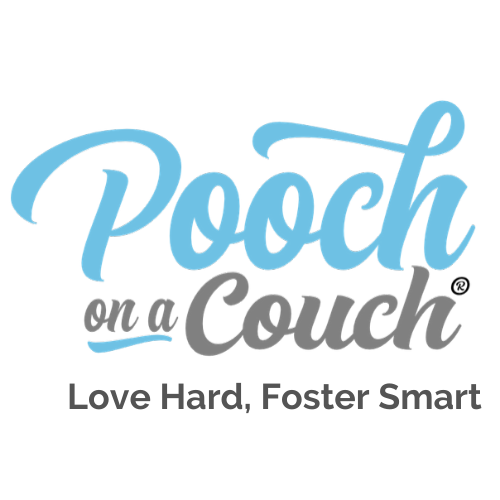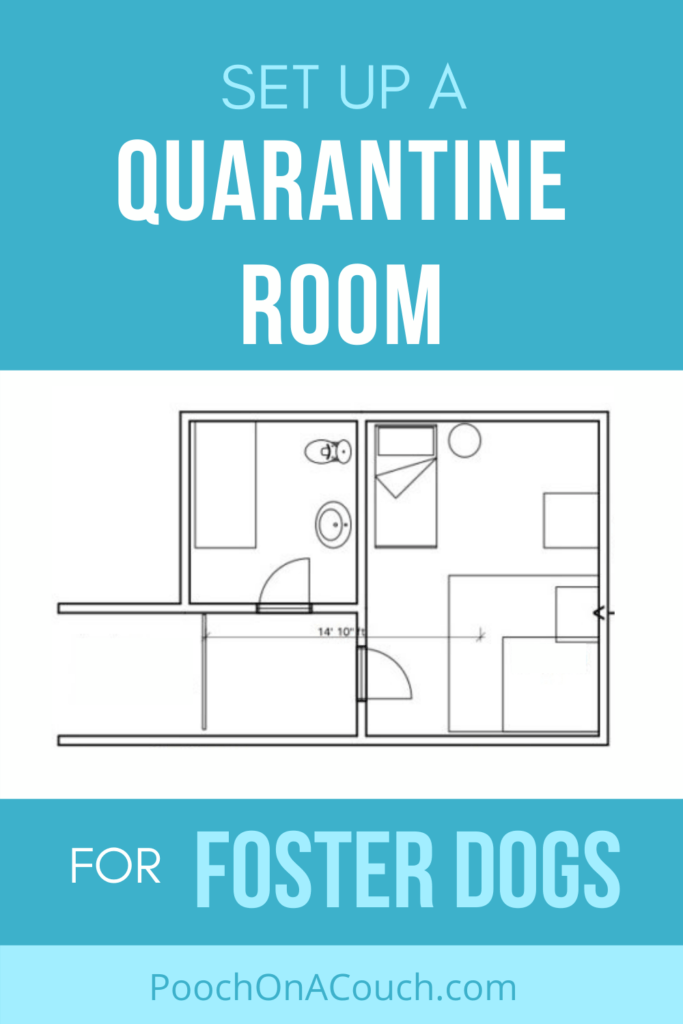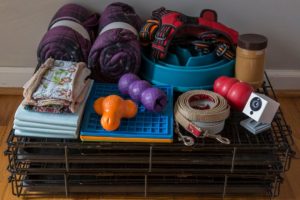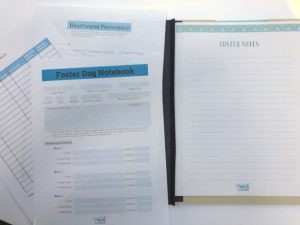As a foster coordinator, I fielded a lot of questions from my foster dog parents. One of the most frequently asked questions was “Is my own dog going to catch a disease from the foster dog and get sick?”
My answer was always, “That depends on if you quarantine your foster dog.”
Disclaimer: This post contains affiliate links. As an affiliate, I may earn a small commission on qualifying purchases at no cost to you.
Most Foster Dogs Will Not Be 100% Healthy When You Get Them
The fact is, we are most often going to be asked to bring in a dog to foster that isn’t yet healthy. And we can safely do that without jeopardizing the health of our personal pets or our family members. We can safely foster a dog and help that dog get well without contaminating our home or yard.
I’m going to help you decide when and how to effectively quarantine your foster dog.
Instructions to Quarantine A Foster Dog Are Often Ignored. Or Are They?
I used to get frustrated when I’d tell a foster home that they needed to quarantine their new foster dog and they wouldn’t do it.
They’d call me two weeks later, complaining that their personal dogs were hacking, coughing, and had snotty noses. I’d reply, “what don’t you understand about the word “QUARANTINE”?
Quarantine: (dictionary.com)
1: a strict isolation imposed to prevent the spread of disease.
Maybe we DON’T understand how to quarantine.
I got to thinking. Maybe we don’t understand how to quarantine. So I googled the word “quarantine” and also googled the term “isolate your pet.”
I found one article from PetMD, “How To Quarantine Your Pet.” The author didn’t provide instructions on how to quarantine, instead talked mostly about why quarantine is needed and suggested you talk to your vet and wash your hands a lot.
Duh.
The next article lumped isolating your pet for behavior management and isolating your pet for illness in the same article. I learned I needed a separate room to isolate. Double duh.
The rest of the articles on page 1 & 2 of Google talked about quarantine in the context of a dog bite or your pet traveling to/from a foreign country.
Quarantine for the purpose of contagion containment is more involved than putting your dog in a separate room and keeping your hands washed.
This is especially true with high contact contagions such as Parvovirus, certain fungi, or intestinal infections such as giardia or coccidia.
Call me over-the-top. I know that I don’t want to spread cooties all over my house. I don’t think you do, either. I don’t want my pets to get sick. I readily admit I don’t like disinfecting an entire house. Am I crazy? I’ll let you decide if you read on!
Some People Dismiss the Need To Quarantine A Foster Dog
I know many seasoned foster dog parents who have become comfortable with subjecting their personal dogs to disease and infections.
“My dog is up to date on the bordetella vaccine” or “My dog has been sick so many times it is now immune.” or “It’s just a cold. It will pass,” they say.
Personally, I think it’s negligent to purposefully expose your pet to the contagions a foster dog can bring home.
If you’ve never witnessed a dog with a severe case of kennel cough or an upper respiratory infection you know that dog feels miserable, it hurts to cough, and the malaise makes you sad and helpless.
Why would anyone think it’s ok for every dog in the house to catch it?
“But, antibiotics will treat it.” “I’m saving lives”. “It’s just part of rescue work”.
No. No it isn’t. It’s reckless, wasteful of funds and resources, and it is unkind.
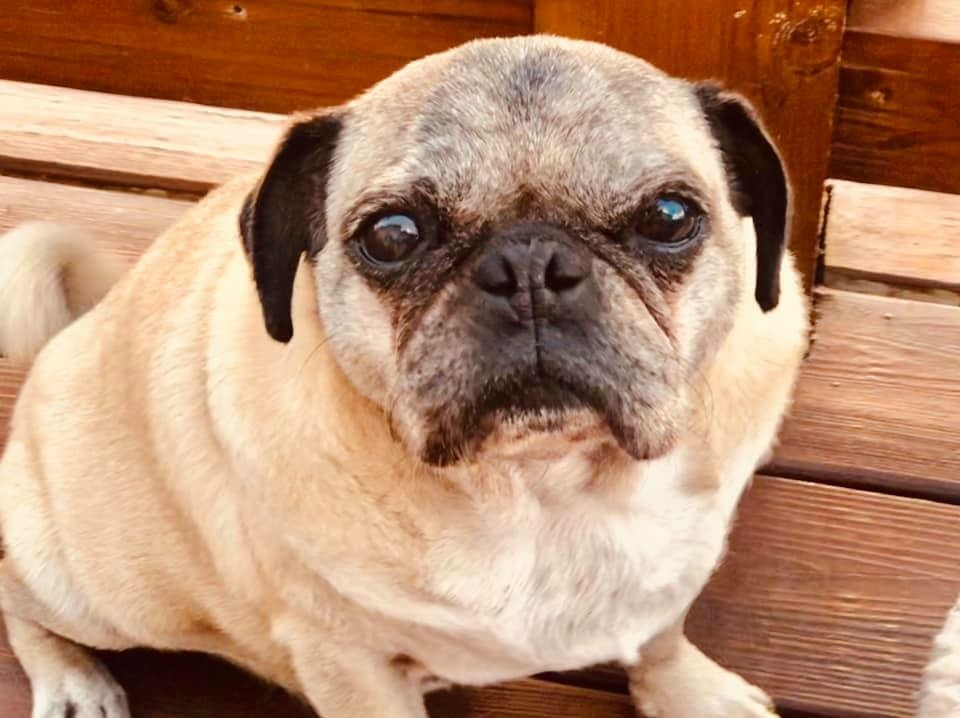
He would have made every dog in my house sick.
Quarantining him was absolutely necessary.
My experiences with quarantine
Most of the time, my foster dogs come from the streets as a stray or they spent some time in an animal shelter.
They quite possibly have been exposed to upper respiratory viruses or came in contact with a dog that has intestinal protozoans like Giardia or Coccidia. All of those are extremely contagious.
Once, I experienced a parvovirus scare and set up my quarantine space expecting this puppy (who reportedly had been exposed to the virus) to break with Parvo. Thankfully, he did not.
Also, I fostered a dog with over 30% of his body covered in ringworm, a highly contagious, zoonotic fungus. This is before I learned how to isolate foster dogs using a quarantine protocol.
That was fun – lots of housekeeping, my fav! – Laundry, vacuuming, bleaching several times a week, not to mention giving Winston his weekly stinky bath! The biggest challenge was keeping the fungal spores contained so they didn’t spread. (My secret weapon? an infant onesie! Winston’s ringworm was located on his torso and feet)
However, due diligence paid off, and no one came down with ringworm during or afterward.
Always Assume You Will Need To Isolate Your Foster Dog
I always assume that any dog I bring home is contagious with something until my veterinarian tells me otherwise.
Furthermore, I place all dogs coming out of shelters in quarantine, and 100% of stray dogs remain isolated until I at least receive fecal O & P test results (takes 24-48 hours, usually). Stray dogs often harbor intestinal parasites and protozoans.
Nearly 100% of my foster dogs are fully evaluated by a veterinarian before coming to my home, or I rescued (and quarantined! ) them overnight or on a weekend and they go to the vet as soon as the door opens the next day. If my foster dog is sick, I want to know about it a.s.a.p.!
I know others who foster rescued dogs on a larger scale may approach managing contagions like URIs (upper respiratory infection) or Giardia and Coccidia by using antibiotics as preventive medicine and dewormers for all on a regular basis – my research and my sources all say this is not best practice. The over-use of these treatments risks them becoming ineffective in the near future.[1] [2] We need our good medicines available for use for years to come!
If you need to quarantine your foster dog, it is not easy but it IS QUITE DOABLE and it brings big pay-offs.

When To Quarantine Your Foster Dog
Your veterinarian is your best source for informing you if you need to quarantine your foster dog or isolate them from the pet population. In addition, tell your veterinarian about your personal pet’s health, too! For example, dogs that are immunocompromised or senior dogs can become more severely ill from a virus or bacterial infection spread from a new foster dog.
Not long after I started volunteering for rescue, a different foster home lost their senior pet to a respiratory infection caught from a new foster dog. She was simply too old and immunocompromised to fight the infection. It was tragic.
Protect all pets by establishing and following a good quarantine protocol!
Below are common conditions for which a rescue dog would need quarantine or an isolation protocol.
Quarantine Your Foster Dog: Not Just For Rabies
If you were to play a word association game and the word was “quarantine”, you’d probably respond with the word, “rabies.” Our public health laws dictate how, when, and where our domesticated pets are managed following a bite from an unvaccinated animal.
Recently, in the county where my family resides, the news stations reported an outbreak of fox attacks – all of the aggressive foxes captured tested positive for the rabies virus. Thankfully, the dogs attacked were up-to-date on their rabies vaccines and avoided long quarantine periods or worse – euthanasia.
On the other hand, people attacked weren’t so fortunate and had to undergo the rabies vaccine series of injections.
[Brief sidebar: no matter your point of view on the over-vaccinating-of-our-pets-discussion, know the consequence in your personal municipality if your not-current-on-vaccines personal pet bites anyone or is bitten by a potentially rabid animal. The laws vary by municipality. Some of those laws are quite tough and heartbreaking.]
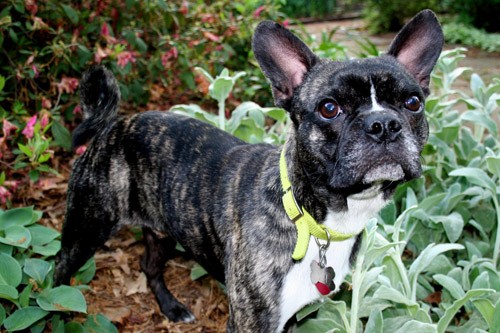
Some Common Illnesses or Pathogens Requiring Isolation or Quarantine:
- Respiratory Infections
- *Influenza
- Bordatella or “Kennel Cough”
- *Severe Ringworm
- *Sarcoptic Mange
- *Giardia
- Coccidia
- Parvo
- Distemper
* these are zoonotic pathogens, meaning humans can possibly contract the condition from infected dogs.
Airborne or Contact? Know How An Infectious Contagion is Spread.
Knowing how a specific infection is spread is going to influence how you set up your quarantine space.
Airborne pathogens are spread by droplets in the air. Dogs spread these when they breathe, cough, or sneeze. Droplets can hang in the air after a dog walks away.
Contact pathogens are spread by touch. Do you remember when, at the beginning of the COVID pandemic, the CDC was telling us to not touch our faces until we’d washed our hands? They were still learning about how this particular Coronavirus spread.
Neutral Zones Help Prevent Spread.
For example, Giardia is a contact contagion, spread through fecal matter on surfaces and in water.
To prevent the spread of Giardia, my isolation protocol is going to be less about a large neutral zone (although I do need enough distance so dogs cannot touch noses or smell butts) and more about restricting where this dog passes stool, keeping infected stools cleaned up, not allowing the infected dog to share water bowls with other dogs, and keeping the area disinfected.
Charlie, probably the sickest dog I’ve ever fostered, contracted an airborne contagion – some type of respiratory infection(s). His fits of coughing and sneezing meant his quarantine plan included wide neutral zones and lots of changes of clothes for me as I provided treatment to him.
I’ll explain neutral zones in the next section.
How To Quarantine Your Foster Dog
I’m going to walk you through my process for setting up a quarantine space when you need to isolate a new foster dog. It is a multi-step process that has worked for me every single time I’ve needed to bring home a very very sick dog.
Choose the Room
First, I choose a spare space where no other pets will be allowed access. Sometimes, no one but me has access.
Establish a Neutral Zone
When dealing with airborne contagions such as respiratory infections, I need a way to set up a barrier (such as a baby gate) a minimum of 10 feet from where the sick dog will be quarantined. This edge of the pen to the edge of the baby gate is what I call “my neutral zone.” No pets at all are allowed to hang in the neutral zone. Alternately, if I’m dealing with something like Giardia or ringworm, my neutral zone could be shorter.
If I’m going to allow my sick dog access to the whole room (I rarely do this) I will need two baby gates: one at the door way to the isolation room and another baby gate 10 feet away. The space between the baby gates becomes the neutral zone.
Choose a well-ventilated space and a space you can easily disinfect. I don’t have a room with bleach-friendly floors, I have hardwoods and carpet. (I can’t quarantine in my bathrooms, either) so here’s what I do after I choose my room:
(and this is going to sound like I’m from crazy town, but bear with me!)
Protect The Floor From Contamination
Next, I purchase plastic sheeting (NOT painter’s plastic – it is too thin) or I purchase a waterproof tarp that is way bigger than the overall size of the x-pen I will use. Usually, a 6′ x 8′ is plenty big.
If I am dealing with infectious body fluids (severe Giardia or when I feared a pup might break with Parvo, for example) I use both layers in the event I get a hole somewhere.
I’m looking to create a waterproof barrier so that infections can’t get into my carpet or into porous hardwood floors.
I’m not a germaphobe by day, but I do take highly contagious illnesses seriously. I do not want a houseful of sick dogs. These plastic barriers can be mopped, which is awesome! (Be prepared to throw that mop away afterwards.)
On top of the plastic, I place a textile barrier. This is usually a flat bed sheet (or several) that I can pull up, wash, and disinfect.
When body fluids are an issue, I put down either washable “chux” pads or disposable pee pads on top of the flat bedsheet. Adding this extra layer makes my daily routine clean-up much easier.
to recap: plastic barrier followed by flat sheets followed by chux pads and/or disposable pee pads.
Now, my space is ready for the equipment I’ll need to quarantine my foster dog.
Set Up The Equipment
- I always confirm with my veterinarian the contagion I am quarantining and ask how wide to make my neutral zone.
- I place a baby gate to barricade to the entrance to the room or the opening of a hallway. This baby gate is a way to set up the neutral zone, helps manage the rest of my dogs and keeps them from curiously approaching the quarantine space and becoming contaminated themselves.
- Be careful about using the door of the room in lieu of a baby gate and neutral zone. I’ve known people to quarantine using only the door to a room as the barrier. Here’s the problem: If dog A is quarantined and puts his nose under the door and dog B, comes up to the door and puts her nose under the door, they’ve made contact and contamination likely happens.
- Next, I place an x-pen on top of my floor barrier. This x-pen is where my quarantined dog gets the freedom to eat, drink, and move about. Unless you want to disinfect the entire room where you are quarantining your dog, use the x-pen. Click the link to see which x-pen I choose: I like this one because I can separate the panels for increased flexibility in set-up.
- I put an open-door crate inside of the x-pen space, or I connect the ends of the x-pen to the sides of the crate. Dogs appreciate the opportunity to den themselves, I think. Use a crate that larger than normally chosen for the size of the foster dog. The dog really doesn’t feel good, but having a little extra space to move around is nice.
- I skip putting the dog bed in the crate – and I suggest you do, too, unless you plan to throw it out or it is covered with an impermeable, washable, bleachable cover. Instead, I use blankets and sheets that are washable and bleachable.
- Bowls for food and water that I can easily and safely bleach. I use stainless steel.
- A side table with a disposable tablecloth for medication storage and dispensing.
- A second crate when I need to clean the first (optional, but recommended!) – I schedule a complete break down of the quarantine space once a week – namely, mop the plastic barrier, pull up all blankets, pads, bowls, etc and do a deep disinfect. Realistically, the contagious dog needs to be confined somewhere while their space is disinfected. You usually don’t want them wandering the room.
Cleaning supplies
This is a list I use – I may or may not need everything on this list depending upon my quarantined dog’s illness.
- bleach
- spray water bottle with 10% bleach solution
- disposable wipes containing bleach
- rags you can wash in bleach or disposable paper towels
- dedicated trash can and trash bags – do not carry your trash to the kitchen can. You are spreading contagions.
- non-latex disposable gloves
- disposable booties for your shoes
- disposable paper gowns or a dedicated over-shirt or smock that you wear while with your sick dog
- soap for you to wash your hands.
Floorplan of a Quarantine Space In My Home
This is a rough layout of a bed/bath in my house, and how I set up a quarantine space for a dog with an URI:
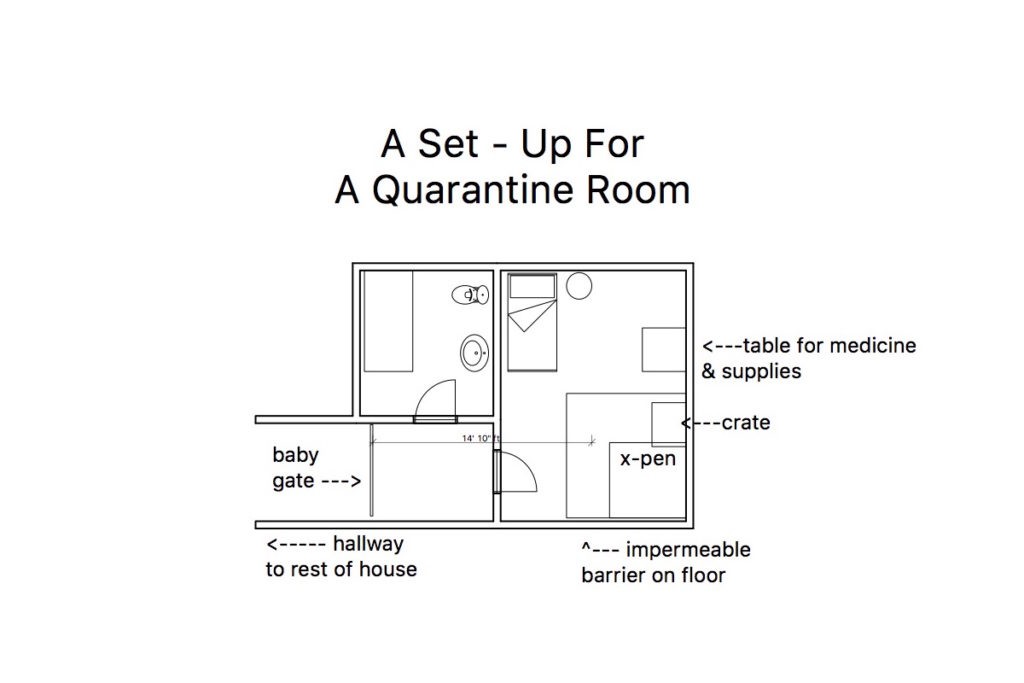
- The neutral zone was about 15 feet long, more distance than I needed.
- The x-pen was attached to the sides of the crate by zip-ties, so the dog had full use of both the x-pen and the crate.
- Anytime I entered this room to provide care or interaction with the quarantined dog, I gowned and gloved up. Once I was done and ready to leave the room – I disrobed, threw the gloves away, and did a good hand wash following the handwashing protocols I learned during my years working in the hospital system.
- Anyone entering the neutral zone or the quarantine zone had strict instructions to follow my protocol.
Once my sick dog was no longer contagious and could join the general population, my equipment was broken down, taken outside for a good cleaning, items that needed washing were washed in bleach, and items that I didn’t want or need anymore were rolled up, put in a trash bag and carried outside.
The room(s) received a good disinfecting wipedown.
All done.
Help Your Foster Dog Cope With Quarantine
Depending upon the reason you are needing to quarantine your foster dog, the dog may feel awful and want nothing more than sleep. However, some social contact is important for healing, so
glove up, gown up, and get in there!
- Wipe the goop out of their eyes.
- Suck the snot out of their nose.
- Wipe the poo out of their toenails.
Talk to them, touch them, and tell them it’s going to be OK.
If they feel OK to interact, spend time with a few low-activity games or play using toys – choose toys you can disinfect immediately after use, especially if you are trying to contain contaminants that can easily re-infect your sick dog. If not, just snuggle for a bit and rub their ears. There are a lot of relaxing pressure points in a dog’s ear pinnae!
Talk with your veterinarian if your foster dog is struggling with isolation before you discontinue to quarantine your foster dog. They have solutions for you to try.
Extreme? Maybe.
Effective? Yep.
I know other people handle fosters with infectious conditions differently. I’ve talked with many fosters, many who have never experienced an outbreak of respiratory infection in their group of dogs. “Lucky you!” is my reply!
There are some nasty, nasty infections coming out of our shelters, hoarding cases, and puppy mill busts. Those infections often spread in a home, sometimes with deadly consequence.
Here’s my plea: When bringing in a sick foster pet, consider the health and robustness of the other pets in the home. Keep in mind the health of humans in the home. Design a plan to keep certain zoonotic infections contained (ringworm, for example.) Quarantine your foster dog! It makes it easier to protect all and minimizing the spread.
Disease spread causes a financial burden of treating multiple pets for an infection when a quarantine would have isolated the contagion. That financial burden may land on the foster home, or the rescue organization may need to divert donor dollars originally earmarked for new intakes. Those monies are precious, hard-earned donations that honestly keep a rescue organization running for one more day. Paying for preventable care is, well – preventable.
Call me that crazy lady. I believe you should quarantine your foster dog when it’s warranted. I care for some pretty sick dogs in my home and none of the others – including my little Indy who had an autoimmune disorder – ever became ill.
Don’t Let Infectious Disease Scare You. Sick Dogs Need Fosters, Too.
Finally, sick dogs need fosters too. They need a safe place to heal while receiving love and care from humans. Don’t let contagions scare you, you now have a plan you can use (that works!) when you need to quarantine your foster dog.
Have you ever quarantined a dog before? What worked? What didn’t? Tell us your stories in comments!
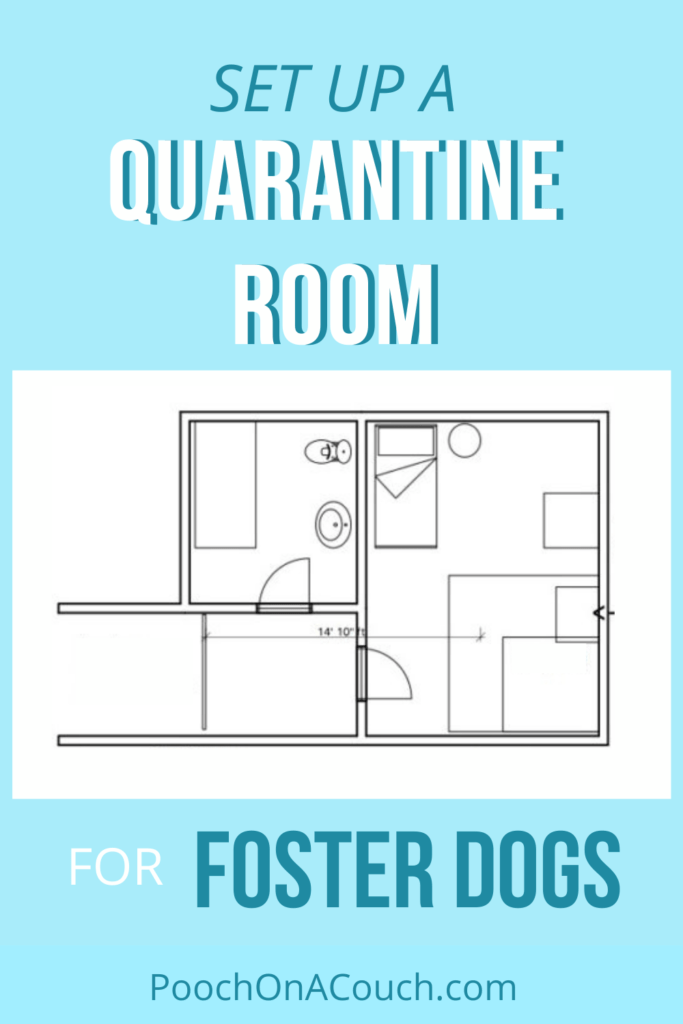
Popular Posts
The Essential Equipment Every Foster Home Should Have
The Ultimate Guide To Fostering Dogs: 10 Skills You Need To Know
Fostering Baci – AKA – How Short-Term Fostering Can Help A Rescue
